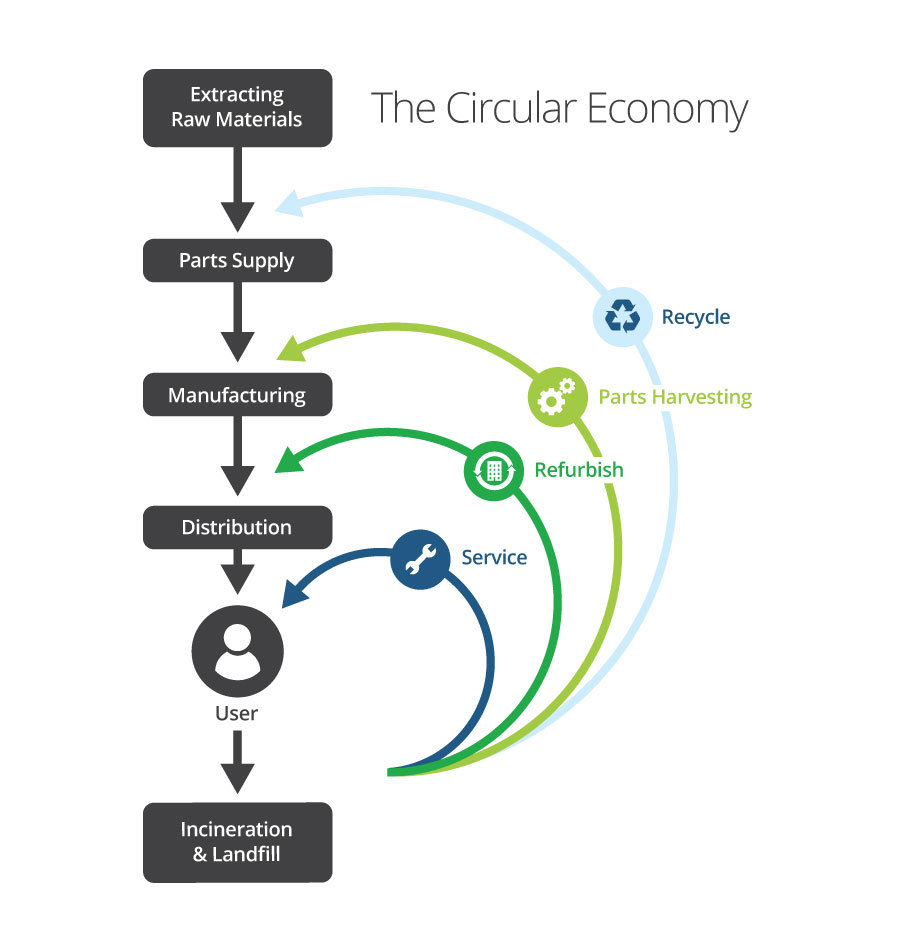December 10, 2019
What is a Circular Economy?
When you think of the term “circular economy”, you might think of natural fibre clothing, glass water bottles, and biodegradable materials.
But by definition a circular economy is the continuous reuse of materials so that nothing is wasted, merely transformed. It is part of the overarching conversation of circularity and how it is the key to sustainability and lowering carbon emissions.
Also called “cradle to cradle”, it’s the opposite of the linear economy (in which items are manufactured, used, and disposed of, generally in a landfill or incinerator).
Here is why a circular economy is needed and how we all can participate to achieve circularity:

Drawing inspired by Braungart & McDonough, Cradle to Cradle

How Can a Circular Economy Benefit Businesses and the Environment
Major industries like energy, manufacturing, IT, or mining and resources aren’t an intuitive association, but they could become a very important part of the circular economy.
Through careful disposition activities, assets that are no longer useful to your company can not only represent a significant investment recovery win, they can represent a major diversion of waste from landfills.
There’s also a great deal of potential economic benefit from the circular economy for enterprises. The World Economic Forum has estimated that the circular economy could generate $1 trillion USD annually by 2025 if more companies altered supply chains for better reusability and recyclability.
As this McKinsey podcast sums up, the circular economy is all about retaining value, and getting the greatest possible benefit from expensive resources.
What Companies Use A Circular Economy Model
One of the earliest examples of a company putting the circular economy to work is over 40 years old. In 1973, Caterpillar changed how it built its tractors and other heavy machinery.
Instead of designing engine and other components with fewer materials, components were designed to be more robust so they could be reused and remanufactured.
Caterpillar’s remanufacturing branch, Cat Reman, buys back components from customers. After dismantling and rebuilding, Cat Reman offers these components at a 40% to 70% smaller cost. The refurbished components meet the same performance standards and most are also warrantied.
The cherry on top is that remanufacturing has increased Caterpillar’s profits.
More Companies Combining Sustainability with Profit
In 2014, Dell announced that it was closing the loop on its supply chain, and has since then reused over 4 million pounds of plastics from its own products.
While the plastics had to be reengineered for reusability, and planning was needed to ensure there was sufficient volume returning to Dell to sustain manufacturing output, the program is a financial success.
The business case for the whole program was based on freeing the company from the price volatility from the global plastics market, which constantly shifted with the price of oil and the competition for recycled plastic.
Similarly, Cisco has been leveraging remanufacturing to improve its bottom line – effectively, they are able to generate income twice or more from each product.
Companies in the petrochemicals industries are exploring ways to capture valuable minerals from salt water used in refining. Drilling fluids and chemicals are being recycled or reused more than ever.
Energy is being recaptured as well, with spent steam, waste gas and heat exchangers adding up to cogeneration opportunities that contribute to a healthier bottom line.
Mining and resources is full of waste from extraction processes, from waste heat to water treatment sludge to rock. Waste rock has a variety of applications from construction backfill to roadway construction aggregate to landscaping.
Mine sludge can be reprocessed to capture valuable minerals, which can be used in cement, glass, bricks, resins, and other applications. Some companies, like Vale mining, are implementing dry processing methods that don’t generate tailings.
Considering that even the tires your fleet rides on are now recyclable, it seems that nothing needs to go to waste anymore.
It’s Easier than You Think to Join the Circular Economy
Your enterprise doesn’t necessarily need a massive R&D investment to start seeing the benefits of the circular economy.
When you sign up to the Requis procurement platform, you can buy, manage and sell your surplus assets. Also you are able to purchase carbon credits to help offset your emissions.
There’s a wide spectrum of recovery buyers already signed up, from OEMs to smaller companies in your industry to scrap dealers.
Give your unneeded assets a new lease on life, and decrease your total cost of ownership at the same time.
